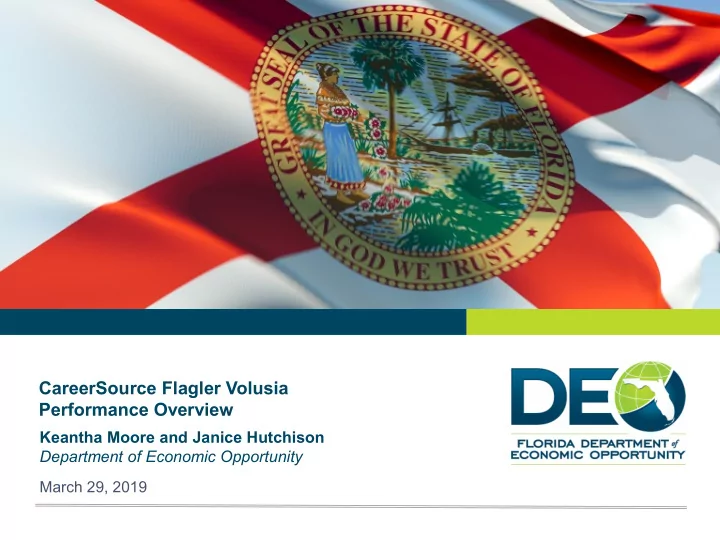

CareerSource Flagler Volusia Performance Overview Keantha Moore and Janice Hutchison Department of Economic Opportunity March 29, 2019
AGENDA • Workforce Structure and Service Delivery Model • Roles and Responsibilities • Program Year 2017 Primary Indicators of Performance • Programmatic Monitoring Activity • Local Area Financial Overview • Workforce Trends 2
FLORIDA’S WORKFORCE SYSTEM United States United States United States Department of Department of Department of General Revenue Health and Human Agriculture Labor Services Governor Department of CareerSource Florida Legislature Economic Opportunity (State Workforce Policy (DEO) Board) 24 Local Workforce Local Elected Officials Development Boards Community Based Organizations Economic Development Partners Workforce Service Delivery Community Partners (Over 75 Career Centers) Training and Service Providers Educational Entities Job Seekers Employers 3
ROLES AND RESPONSIBILITIES Local Elected Officials (LEO) Roles and Responsibilities • Select the Chief Local Elected Official (CLEO) • Assume liability for Workforce Innovation and Opportunity Act (WIOA) program funds • Appoint the Local Workforce Development Board (LWDB) members • Approve the LWDB-developed WIOA budget 4
ROLES AND RESPONSIBILITIES CLEO/Board Joint Roles and Responsibilities • Develop/submit the local WIOA plan • Conduct oversight and monitoring of the One-Stop system, Youth Activities and Employment and Training Activities • Set policy for WIOA activities and services consistent with state and federal policies • Select One-Stop Operators • Negotiate and reach agreement on local performance measures • Respond to monitoring findings 5
PRIMARY INDICATORS OF PERFORMANCE • WIOA establishes performance indicators and reporting requirements to assess the state’s and local area’s effectiveness in serving individuals participating in the workforce development system. • Indicator’s displayed consist of: 3 Adult Indicators 3 Dislocated Worker Indicators 2 Youth Indicators 3 Wagner-Peyser Indicators 6
WIOA PRIMARY INDICATORS OF PERFORMANCE LWDA 11 PY 2017 PY 2017 PY 2017 PY 2018 Program Year (PY) 2017 Actual Performance Achievement Performance July 1, 2017 – June 30, 2018 Performance Targets Level Targets Adults : Employed 2 nd Quarter After Exit 88.40% 89.00% 99.33% 86.00% Employed 4 th Quarter After Exit 86.90% 85.00% 102.24% 82.50% Median Wage 2 nd Quarter After Exit $7,055.00 $7,850.00 89.87% $6,850.00 62.50% N/A N/A 74.00% Credential Attainment * Dislocated Workers : Employed 2 nd Quarter After Exit 82.80% 83.00% 99.76% 83.00% Employed 4 th Quarter After Exit 75.00% 79.00% 94.94% 79.00% Median Wage 2 nd Quarter After Exit $5,549.00 $6,850.00 81.01% $6,850.00 Credential Attainment * 77.80% N/A N/A 74.00% Youth Common Measures : Education and Employment Rate 2 nd Quarter After Exit 77.70% 76.00% 102.24% 76.00% Education and Employment Rate 4 th Quarter After Exit 64.10% 69.00% 92.90% 69.00% Credential Attainment * 94.90% N/A N/A 75.20% Wagner-Peyser: Employed 2 nd Quarter After Exit 66.00% 64.00% 103.13% 62.00% Employed 4 th Quarter After Exit 66.70% 64.00% 104.22% 64.00% Median Wage 2 nd Quarter After Exit $4,793.00 98.82% $4,850.00 $4,850.00 Not Met (less than 90% of target) Met (90-100% of negotiated) Exceeded (greater than 100% of negotiated) 7
PROGRAMMATIC MONITORING ACTIVITY • Federal law requires the state to develop an oversight system to monitor all workforce programs receiving federal funds. • DEO, in consultation with CareerSource Florida, annually develops and implements a process for monitoring LWDBs. • Corrective Action Plans to address all findings are required. • Programmatic and financial monitoring is completed annually. 8
PROGRAM YEAR 2017 SUMMARY OF LOCAL FINDINGS PY 2016 PY 2017 Program Findings Findings Welfare Transition 3 2 Wagner-Peyser (RESEA, MSFW, 5 4 Career Center Credentialing, MIS) Supplemental Nutrition Assistance 0 1 Program - Employment and Training WIOA Adult / Dislocated Worker / 1 1 Youth Trade Adjustment Assistance Act 3 0 Total Findings 12 8 9
FISCAL YEAR 2017 SUMMARY OF THE RESULTS OF FINANCIAL MONITORING CATEGORIES RESULTS Findings None Issues of Non-Compliance None Observations None Technical Assistance 2 10
PROGRAM YEAR 2018 TOTAL STATEWIDE FUNDING $6,139,942 $1,568,666 3% $10,142,480 1% Workforce Innovation 5% $1,030,000 and Opportunity Act 1% $27,016,202 12% Welfare Transition Wagner Peyser Veterans $133,143,442 $52,514,907 24% 54% Supplemental Nutrition Assistance Program Trade Adjustment Assistance Program Reemployment Assistance State Total: $231,555,639 11
PROGRAM YEAR 2018 TOTAL LOCAL AMOUNT $281,931 $80,075 4% 1% $309,512 $30,018 Workforce Innovation 4% 0% and Opportunity Act $810,866 11% Welfare Transition Wagner Peyser Veterans $4,109,757 $1,931,799 54% 26% Supplemental Nutrition Assistance Program Trade Adjustment Assistance Program Reemployment Assistance Local Total: $7,553,958 12
PROGRAM YEAR 2017 DIRECT CLIENT SERVICES & ADMINISTRATIVE EXPENDITURES 93% Out of a total of $6,118,634 in workforce 7% expenditures last year, $452,532 was spent on administration by the local board. Direct Client Services Administrative Expenditures 13 8
PROGRAM YEAR 2017 ITA EXPENDITURE REQUIREMENT 66.43% 35.00% Annual ITA Expenditure ITA Expenditures Requirement 14
PROGRAM YEAR 2016 & 2017 WIOA WE REQUIREMENT *WIOA Requirement: 20% Work Experience 21.49% 16.22% PY2016 PY2017 15
PROGRAM YEAR 2017 PERCENTAGE OF EXPENDITURES ON OUT-OF-SCHOOL YOUTH 0.00 0% Out-of-School *WIOA Requirement: 75% Out-of-School 779,006.73 100% In-School 16
WORKFORCE TRENDS Apprenticeships – Nationwide employers have hired over 411,000 apprentices since January 1, 2017. Gig Economy – 55 million people in U.S. are “gig” workers, more than 35% of the U.S. workforce and that number is projected to increase to 43% by 2020. Soft Skills – According to a 2018 Workplace Learning Report by LinkedIn, employers have identified soft skills as their top training priority. 17
QUESTIONS 18
ADDITIONAL INFORMATION For more information, please contact: Casey Penn Florida Department of Economic Opportunity One-Stop and Program Support (850) 245-7485 Casey.Penn@deo.myflorida.com 19
Recommend
More recommend